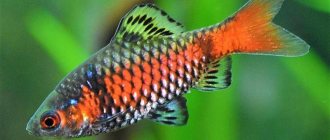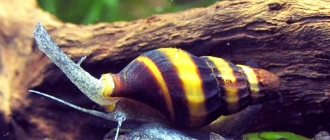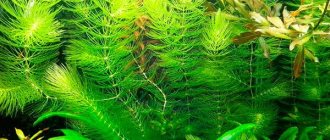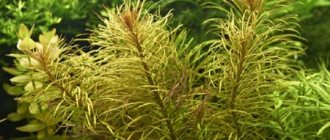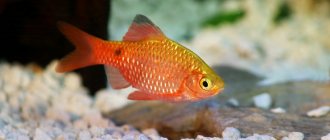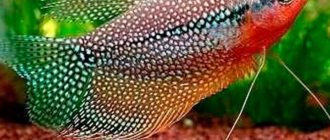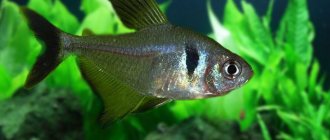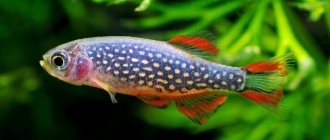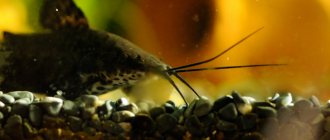Aquarium volume
First of all, you should understand that carp is a big fish. And koi, of course, are no exception. By the age of six years of life in a pond, it can reach a length of 70 cm and weigh 6-7 kilograms. In an aquarium it will, of course, be much, much smaller. Once every 5. However, the reservoir must be not just large, but very large. For every 1 cm of body there should be 5 liters of water. That is, for a school of koi carp 15 cm long, you will need a tank with a volume of 1000 liters. And this does not take into account further growth.
In principle, you can limit yourself to keeping medium-sized individuals, but in this case you risk never seeing the full beauty of these amazing fish. Once you “collide” with purebred ten-year-old specimens, you will no longer want to bother with the angular juveniles.
Description, origin and natural habitat
Koi carps (Nishikigoi in Japanese pronunciation) have the second name Brocade Carp and are an ornamental species of the domesticated Amur subspecies of carp.
In the scientific classification, a Koi carp is an individual that has passed six selection selections with an assigned category.
These fish were first brought to China 2.5 thousand years ago from areas adjacent to the Caspian Sea. Most likely, Carp was first domesticated in Persia, but there is no scientific confirmation of this fact. And the word “carp” itself has roots from the ancient High German language and sounds like “Charpfen”.
In Japanese, “carp” means “koi”, but this word has another semantic meaning, it is a homophone (phonetic ambiguity) with the concepts of “love”, “intimacy”, “affection”.
The first mentions of Koi Carp in Japan date back to the 14th-15th centuries, and according to some sources, to the 8th. Then these fish in the land of the rising sun were called Magoi, which means Black Carp.
Photo gallery of Karpov Koi:
Later they began to be bred here as a commercial species; for many mountainous provinces it was the only available protein food. And this is, first of all, the Niigata Prefecture, which is associated among aquarists around the world with Takeshi Amano, the legendary aquatic artist. This province is located high in the mountains, there are very hot short summers and harsh winters with such heavy snowfalls that sometimes the thickness of the cover reaches 10 m.
Residents of the province found themselves cut off from the world for a long time due to harsh winters and lack of roads; they ate rice and vegetables, and deep underground reservoirs were dug for irrigation. It was these reservoirs that were ideal for imported carp. In May-June, the fish spawned, and in October the juveniles had already reached a decent size and most of them were stored for the winter. The peasants valued the producers very much and for the winter they built special aquariums for them and moved them into their houses.
It was then that the individuals bred in pond farms began to experience natural mutations and, as a consequence, color changes.
The first specimens were bright red, then snow-white. After crossing them, white and red Koi appeared.
Those specimens that were expressively and intricately colored were not eaten, but were released into water bodies as decorative pets. This has become a real passion for the poorest people in Japan. Bright fish were crossed with each other, obtaining new, more interesting color variations.
Gradually, the Japanese nobility also became interested in Koi breeding, and then this hobby became very popular all over the world. The fish aroused especially great interest at the Tokyo Taisho Exhibition, which took place in 1914. Nowadays there are various associations and clubs for Koi carp lovers.
In the Land of the Rising Sun itself, not a single household or park is complete without a pond with Koi Carp; there are carp ponds in Buddhist monasteries and in illuminated city fountains.
As a rule, females participate in competitions - their bodies are larger and stronger. A fish is not even considered as a participant for evaluation if it is less than 40-50 cm. The largest specimen in the entire history of the competition reached a length of 120 cm and weighed about 40 kg. The sizes and shapes of the fin plumage and head, and the general proportions of the body structure are also assessed.
Skin colors and patterns play an important role in the awarding of the Koi category. Preference is given to clear and clean boundaries of spots, their number is limited, and their locations are strictly specified.
In addition, the pet’s general behavior and its posture when moving in a body of water are examined and assessed. Karp is then given an overall summary of all the scores and opinions of the judges.
The cost of breeding specimens for breeding is estimated at thousands of dollars, although you can buy fry very cheaply, it all depends on the quality of a particular specimen.
The most phenomenal Koi sale took place in America when a female was sold for $50,000. And in Japanese families, Brocade Carps are included in wills as valuable inherited property.
The endurance and unpretentiousness of the Brocade Carp and its lifespan are highly valued in Japanese culture. Individuals are known, in particular Koi Honako, who lived 226 years. This case is unique, but ordinary pets rarely die before 50 years of age.
In addition, these truly domestic pets are very smart and are able to remember and carry out up to 20 commands from their owner. They easily get used to it, take food from a person’s hand, and allow themselves to be petted.
The appearance of the Koi has undergone significant changes as a result of centuries of selection and is very different from its distant ancestor. But these are still large fish, reaching a length of 55-70 cm and a weight of about 6-10 kg.
Koi has a large head with characteristic mustaches and an elongated body with a single powerful caudal fin, allowing it to easily perform various maneuvers in the water. The rest of the plumage is also well developed and proportional to the size of the body.
The color of the scales depends on the specific variety and conditions of detention. Color is influenced by many factors - the quality of water and food, lighting, and the size of the reservoir.
Sexual dimorphism is weakly expressed, the female becomes slightly larger with the onset of sexual maturity. These are omnivores and fairly calm fish, showing some aggression only during the spawning period (May-June).
Necessary equipment
In general, koi carp are unpretentious creatures, but muddy water will ruin the pleasure of admiring them. This means that you cannot do without specialized equipment.
The filter must be powerful. Buy a high-performance external filter with a large filter tank volume. Ideally, there should be several filters (2-3). There is no need to wash them frequently; do this only when you notice a significant decrease in pressure. Pay special attention to filter materials, which should not be finely porous. Otherwise, rapid clogging of the filter cannot be avoided.
Aeration. Koi carp can tolerate a lack of oxygen quite well. Lack of aeration in the presence of a high-quality filter is unlikely to lead to the death of pets. But watching fish greedily swallow air from the surface is not a pleasant pleasure. So it’s better to make sure that there is as much oxygen as the carp needs.
Sterilizer. Perhaps someone will say that this thing is useless. However, as practice shows, in large aquariums an ultraviolet sterilizer is indispensable. It will ensure the cleanliness of the aquatic environment and protect fish from unwanted bacterial outbreaks.
Lamps. The lighting in the pond for koi carp should be intense. Light helps fish maintain the natural brightness of their scales. Unfortunately, at home (even when using lamps that are similar in nature to natural light), carps become noticeably pale. Try to provide maximum sunlight exposure to the aquarium, supplemented by exposure to metal halide lamps. The lights should be turned off at night.
Recommended water parameters: temperature - 15-30 degrees, hardness - 1-7, acidity - 7-7.5, oxygen level - 4-5 mg/l.
Diseases and prevention
Koi carps are very hardy fish with a strong immune system, but they also do not like sharp fluctuations in the parameters of the aquatic environment, which can manifest themselves in the appearance of ulcers and wounds on the body of pets.
Poor quality water causes gill and fin rot, ichthyophthyriasis, gopherellosis, cryptobiosis, costiosis, chilodonellosis, and other infections and can lead to the death of precious pets. To save the fish, it is necessary to immediately normalize the quality of the housing and use saline solutions and Malachite green for treatment.
As a result of decreased immunity from sudden temperature changes, pathologies may occur:
- Carp pox. Fish are affected by viral herpes, and tubercles and growths appear on their bodies. You should immediately contact a veterinarian-ichthyologist.
- Spring viremia of carp (SVC) or ascites. The fish's belly swells and the swim bladder begins to become inflamed. Only a specialist can help in the early stages of the disease.
Bacterial infections such as pseudomocosis, aeromocytosis, and epitheliocytosis require treatment with antibiotics.
Feeding
You should feed several times a day, but little by little. The main food of koi carp is dry food with spirulina, axtaxanthin and other carotenoids that enhance color. This rule applies exclusively to adults. A young animal's liver may not be able to handle large amounts of vitamin A, causing the white areas on the body to turn yellow.
Be sure to supplement the menu with fruits and vegetables cut into small pieces, any cereals, and dandelion leaves. Koi love shrimp, worms, daphnia, eggs, lettuce, and melons. It is important that portions are eaten quickly.
Food should be varied. Live food should not be given in large quantities. This is dessert. Do not feed carp bakery products that activate fermentation processes.
Remember simple feeding rules:
- food should be eaten within 5-8 minutes;
- food should not, settling to the bottom, pollute the aquarium;
- avoid overfeeding fish;
- feed 2-3 times a day in small portions;
- The daily food intake for koi carp is 3% of the total weight.
If you feed pellets (floating sticks), then give preference to one manufacturer. If you combine different types of food, then for convenience, create a schedule and strictly follow it.
Reproduction
Breeding koi is only possible in a pond. The ability to reproduce appears at sufficiently large sizes, which can rarely be achieved in the confined space of a glass jar. In addition, koi consider aquarium conditions unsuitable for procreation.
How to determine sex: this may be difficult; females and males are difficult to distinguish. There are practically no gender differences, and even if there are any assumptions, they may be erroneous.
Since koi are usually kept in large flocks, it is not necessary to determine the sex. If conditions are right, fish spawn massively in the pond around the end of spring. In this case, they need to be fed better (more live food) and watch how the offspring grow.
If breeding koi carp is your goal, then you will have to prepare a spawning pond. Dig a separate or install a small pool and monitor the cleanliness of the water. Several males (2-3) and one female settle there. During the spawning process, the eggs are transferred to another aquarium because these always hungry fish will eat the eggs and eventually the fry.
The fry appear after 5-7 days. They attach to the walls of the container and hang there for another 2-3 days. It is important to remember that they need oxygen to develop, so a compressor is a must. They begin to feed the fry from the moment the fry peel off the walls and begin to swim. The starting food is standard for fry - daphnia, cyclops, small dry food for babies.
Adaptation and Compatibility
Koi carps do not immediately get used to new conditions. Especially adults. At first, they will huddle in corners and become afraid of your approach. This is fine. Juveniles adapt easier and much faster. Be patient and very soon your new charges will recognize you and let you approach them. Carps can be trained - they remember not only the appearance of the owner, but also various sound and light effects.
Koi are well compatible with goldfish and their varieties, minnows, trout, platies, and catfish. Partially compatible with Botia, Ancitrus and Plecostomus. It is not recommended to house koi carps with angelfish, bettas, barbs, danios, discus fish, tetras, guppies, gouramis - sooner or later they will end up in their stomachs.
Primary colors in painting
More than 80 breeds of koi carp have been developed. Their characteristics are quite similar. The only differences are in the shape of the spots, their location and color. The main colors that predominate in the color of fish are as follows:
- red;
- blue;
- white;
- black;
- cream;
- gold.
Types of koi carp with their names.
Sometimes fans call golden-colored fish golden fleece, but this is not the official name.
Koi carps at home: pros and cons
Before keeping koi carp in your home aquarium, as well as any other fish, you should weigh the pros and cons.
Pros:
- unpretentious in care;
- omnivorous;
- beautiful;
- susceptible to training;
- easily get used to the surrounding temperature;
- rarely get sick.
Minuses:
- are unlikely to grow large (the average length of domestic carp is 15 cm);
- will not reproduce (for this they must grow to at least 23 cm);
- the color intensity will be weaker due to lack of sunlight;
- increased metabolism will require high-quality equipment, regular water changes (30% weekly) and thorough general cleaning.
Pond Basics
Brocade Carps live on average 25-50 years and most often die not due to aging changes, but from diseases. In principle, there are also cases of longer life of pets. During this time, they can grow to 80-130 cm in length and reach a weight of 40 kg. In this case, keeping them in an aquarium is simply unwise.
In principle, making a pond for pets is not difficult. There are two options - a concrete base and soft waterproofing in the form of synthetic rubber and special fleece for the backing (to eliminate sharp stones).
It is more expensive to install a concrete base, but it will last a very long time, almost forever.
It is recommended to make a reservoir with a minimum depth of 1.5 m and a capacity of 7-8 tons. The approximate dimensions are 2.8 x 2.56 x 1.2 m, but they depend on the number of individuals planned in the pond. The calculations should be the same as for keeping an aquarium - for every centimeter of fish, 5 liters of water. Active pets need a lot of space to move around.
The pond should be located in a quiet and peaceful place, away from roads, under bright sunlight. Storm drainage must be provided around the pond to prevent melt and rainwater from flowing into the pond.
Don’t forget about filtration – biological and mechanical. You can refuse it only if the reservoir is large and there are a lot of aquatic plants in it.
A few more tips
- the larger the volume of the aquarium, the more opportunities for the growth of young animals;
- carps cannot tolerate rotten and acidic water;
- Veil and mirror varieties of koi carp look especially attractive;
- fish sleep lying on their sides in complete darkness, so do not forget to turn off the lights at night;
- if your goal is to keep small carp, then the daily food intake should not exceed 1.5% of the total weight;
- An increase in temperature above 27 degrees enhances metabolic processes, as a result of which the tank quickly becomes dirty. Low temperatures make it difficult to absorb nutrients;
- equip the pond with a two-stage filtration system (mechanical and biological). This will have a beneficial effect on the well-being and appearance of underwater inhabitants.
Cold weather care
Overwintering carp in a harsh climate, especially in a pond, must be provided with the necessary conditions for their comfortable life in winter. The minimum water temperature in winter is + 4°C. Wintering of carp should take place in a place protected from the cold or covered with a polyethylene base. In the pond, carp spend the winter in a wintering hole 1.5 meters deep, where the filters are turned off and several holes are punched in the ice. These openings should be regularly cleared of ice build-up and provided with aeration and a heating device to prevent them from becoming clogged. Overwintering of koi is also associated with a decrease in their appetite, which will awaken only in spring. The fish will use algae as food. When the temperature drops, carp prepare for hibernation and suspend the functioning of the digestive system. In aquarium conditions, wintering fish will be easier and will require less effort from their owner.
4 SMALLEST AQUARIUM FISH
HOW TO CARE FOR GUPPIES AT HOME
10 MOST BEAUTIFUL AQUARIUM FISH
Types of fish suitable for breeding in aquariums
Carp is the most common fish for breeding in ponds and aquariums. The popularity of carp is associated with a large number of valuable biological features and convenient economic qualities.
Based on the variety of scales, there are 4 types of carp: mirror, scaly, leathery and mirror linear naked. A separate species is the domesticated koi carp.
Carp is superior to many freshwater fish in omnivorousness, endurance and growth rate. He is very unpretentious to the conditions of detention and easily adapts to changes in any factors.
Carps are very prolific, so they need a very large aquarium. The female can lay more than 1 million eggs with her own weight of 5-8 kg. Fertility is related to housing conditions, and the better they are, the higher the fertility. This is a large fish and in good conditions carp can reach a weight of 25 kg and a length of more than a meter. You shouldn’t expect this in an aquarium, but it’s better not to keep this fish in close quarters.
Goldfish are another very hardy fish that can adapt to any environment. Able to survive in cramped conditions, in conditions of acute lack of oxygen. It loves very silted, stagnant bodies of water in nature; its aquarium must be filled with plants. Rare cases indicate that it can grow up to 3 kg, but most often the weight does not exceed 500-600 g, and in an aquarium you should count on 200-300. When breeding, you can crossbreed with other types of fish, for example, with carp.
Silver crucian carp, like golden crucian carp, is unpretentious to living conditions, but its size is even smaller and its weight does not exceed 400 g. It is successfully crossed when bred with carp and golden crucian carp.
Kinds
Koi are classified by body color, and there are many such species. For convenience, Japanese aquarists have combined fish species into 16 groups, bearing the following names:
- Kohaku is a variety with a light body, decorated with scarlet or orange spots.
- Taise Sanseku are light-colored fish with scarlet and jet-black markings.
- Seva Sanseku is a fish with a black color, complemented by scarlet and snow-white splashes.
- Utsurimono is a jet black koi with multi-colored markings.
- Bakko - the color of the fish is made in orange, red, light or yellowish tones. The body is dotted with dark spots.
- Tante - this variety differs from others in the scarlet spot adorning its head.
- Asagi is a fish with blue-gray scales and an orange belly.
- Shusui is a mirror-colored koi with large scales evenly spaced from head to tail.
- Koromo is a fish with scarlet and dark spots.
- Kingirin - varieties with different shades, the peculiarity is a pearlescent or golden tint.
- Kawarimono - this group includes representatives with a color unusual for other koi.
- Ogon - monochromatic phenotypes: gray, orange, scarlet or yellow.
- Hikari-moemono are fish with a steely sheen and various body colors.
- Goshiki are dark carps with scarlet, yellow or cornflower blue spots.
- Doitsu-goi - representatives are distinguished by large scales or the absence of them.
- Kumonryu are jet black fish with milky markings.
Each variety is beautiful and unique, and can become a real decoration for any pond or reservoir. The right light and a minimal amount of decorations will help to emphasize the elegance and grace of the koi.
Choosing fish for breeding
Most often, the choice of fish for breeding in an aquarium stops at carp - scaly or koi. According to legends, the domestication of carp occurred in Persia.
Koi are often found even in small apartment aquariums, as they are unpretentious, and their colors are very diverse, there are about 14 types of colors in total. There are red, blue, yellow and orange koi, in addition to a variety of spotted ones.
The best environment for breeding any fish for slaughter is a body of water, the conditions in which are close to natural, but carps, due to their endurance, can be successfully bred in spacious aquariums. The aquarium must have all the necessary equipment for filtering and aerating the water, and the water must be changed weekly. For carp, it is important that there is soil at the bottom of the aquarium that completely covers it. You can replace the soil with sand or pebbles.
Mr. Tail recommends: variety of species
There are many varieties of Japanese Koi today, more than 80, they are divided into 16 groups, and only 14 are accepted as standard colors for evaluation. But they also have limited basic colors, namely:
- cream;
- yellow;
- orange;
- white;
- red;
- black;
- blue.
The formation of colors occurs as a result of a certain combination of pigments, there are only three types:
- Melanophores responsible for black color.
- Xanthophores that form yellow and orange tones.
- Guanophores responsible for the shine of scales.
For example, orange Koi have no melanophores at all, Blue carp have virtually no xanthophores, and white carp have neither one nor the other enzyme.
Let us list all 16 groups of Koi carps adopted by Japanese breeders.
Koi Asaga Asagi
Individuals completely covered with scaly plates have a patterned light mesh on a dark blue back. The color on the sides, belly and fin plumage is red.
This group has a subspecies Shusua, representing scaleless individuals of a similar color.
Carps Becky Bekko
The main color is a combination of white, red and lemon colors, interspersed with black markings. Ideally, a large head should not have any spots at all.
Koi Goshika Goshiki
The main background of the body is charcoal, with purple, snow, brown and blue stains on it.
Koi Doitsu
This is a scaleless variety obtained by crossing with the naked German species of carp. The color can be any; several rows of mirror scales are allowed on the sides.
Carp Kawarimoni Kawarimono
These are individuals not included in other groups, of different colors, which completely lack gloss.
Koi Kingirini Kin-Gin-Rin
This sparkling group consists of two classes:
- Gin-rini are specimens of any color; the scales have a golden sheen.
- Kin-rini - these carp have scales with silver tints.
Koi Koromi Koromo
The literal translation of the name is “with a veil applied” or “clothed in a veil.” The main body color is ruby, the pattern resembles a dark mesh.
Koi Kohaki Kohaku
This is the main, most widespread group of Brocade Carp in aquarium farming. Markings of a ruby or red-orange hue twinkle like bright stars on the snow-white body. Their boundaries must be clearly defined for high assessment. Depending on the type of pattern, nine subspecies of Kohaki are distinguished.
Carp Ogoni Ogon
The main body color is monochromatic, there are no patterns, marks or spots. Color variations are possible in five forms:
- red;
- orange;
- gray (blue);
- yellow;
- lemon
Koi Shusui Shusui
These carp have a distinctive coloration with blue or blue backs and large ruby markings on their sides.
Carps Taisha Senke
The main color of these individuals is white, the markings are red and black. The group received its name in honor of the Japanese Emperor Taisho.
Koi Tanchi Tancho
The color of this group of Koi Carp is unique. The main background is snowy, one ruby spot is located on the head (symbolism of the Japanese flag). The most valuable are those with round markings.
Tanchi is another symbol of the country, a white crane with a red cap on its head.
Koi carp Utsurimoni Utsurimono
These fish have black bodies, with stains of three colors on them - purple, snow and lemon.
Koi Hikaro-moyomono Hikari-moyomono
The color of these individuals is gold and silver, scales with a mirror shine.
Sevi Sanseki carps
The main background color of the body is charcoal, the spots are red and white. The group is named after another Japanese emperor.
Koi Kumanri Kumonryu
The name of the variety means "water dragon". These are scaleless individuals with snow markings on the body, head and abdomen.
Description
A species of freshwater ornamental fish from the carp family. The body size of pond inhabitants is on average 90–100 cm, less often 130 cm. In the aquarium, koi carps are small - 20–30 cm, but there are species up to 70 cm.
Breeders evaluate the appearance of koi carp. Body parts must obey certain proportions.
Body parts
Most species have a large, broad head with a blunt nose. The pectoral fins are highly developed. The body begins to narrow in the area of the dorsal fin. When viewed from above, the body looks even and proportional. Breeders look at the skin, the color should be bright, the skin should be healthy, and the spots on the body should be clearly limited and distributed evenly over the entire surface. The pattern on the body is commensurate with a carp.
How long do koi carps live?
Ornamental carps are long-lived, in captivity they live up to 35 years, with good care they can live up to 100. There are known cases of reaching 220 years.
Decorations and vegetation
The soil in the aquarium should consist of fine or medium sand. If there are any bottom communications, it is better to securely secure them with special silicone and sprinkle them with sand.
There is no doubt: all the soil will definitely be dug up, elements of the aquarium interior (if any) will be turned over or shifted.
This is one of the reasons why Koi fans don't think much about decorations. But the main reason is that bright and powerful koi themselves are a kind of decoration not only for the aquarium, but for the entire room.
That is why the main task that needs to be solved is choosing the optimal place where there will be a large home pond with majestic carp.
As for plants, experts do not advise planting them in the ground - they will undoubtedly be destroyed. The best option is pots with plants (for example, water lilies), suspended at a depth of 10-15 cm from the bottom. There should not be many such pots, as they need space.
